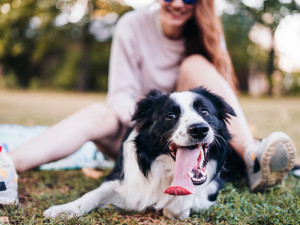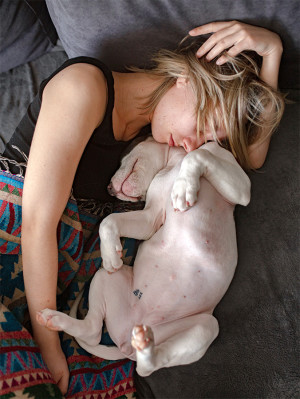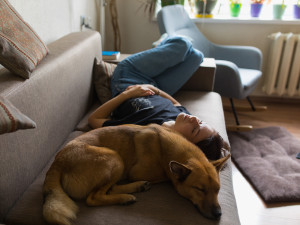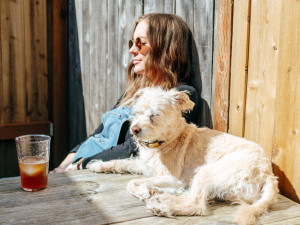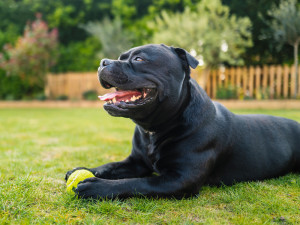Why Is Your Dog Panting At Night?
Everything OK, bud?
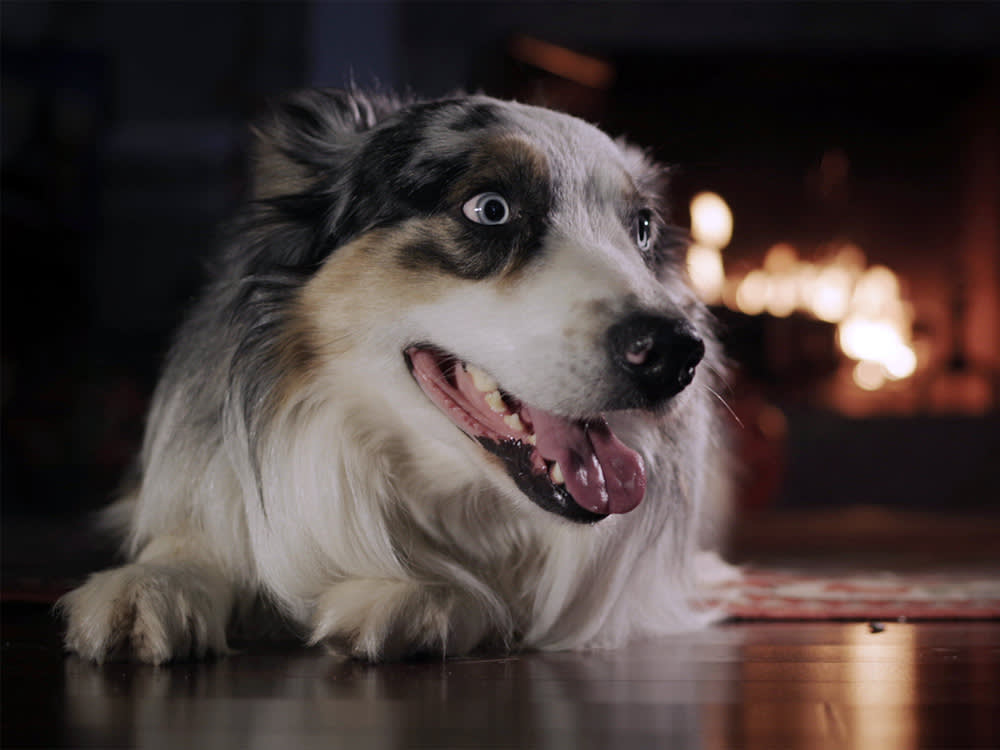
Share Article
If you wake up to your dog’s hot breath on your face, or feel your whole bed shaking because your dog is panting heavily during the night, you’ll recognize that something is up with your pup right away. Dogs pant for a number of reasons, including both physical and behavioral causes.
Panting can be a normal response to feeling hot, so if you live in a warm climate, or your dog has a thick fur coat, this may be an appropriate reaction. If your pup suddenly starts panting at night and it is accompanied by any other physical or behavior changes like decreased appetite, lethargy, coughing, vomiting, whining, or pacing, it’s important to see a vet for a thorough evaluation to rule out more serious medical conditions.
It can be helpful to try to further characterize your dog’s panting by paying attention to factors like whether they are asleep or awake while panting, if other signs are present, and any other patterns like specific times of night or other activities that may be happening at the same time. Read on to learn more about the common causes for panting and how to help your pup get relief.

Deep sleep and dreaming
One of the cutest and most benign explanations for panting at night is dreaming and the REM phase of sleep. Some dogs have very active phases of sleep where they may move their limbs, vocalize, breathe quickly, or pant while they are sleeping.
These phases are only part of the sleep cycle and should subside during a long rest period. If your dog is completely fine when they are awake and only experiences these signs occasionally during sleep, it can be a normal part of their sleep cycle and nothing to be concerned about.
Temperature regulation
Panting is the primary way that dogs keep cool. Most of the time, if your dog is panting, this is the explanation. Dogs will pant on a hot day, if they have thick fur, or if they have recently been very active and need to cool off. They can also combine panting with other physical changes to help cool off.
How do dogs regulate body temperature?
Panting: Panting allows dogs to quickly move air across their respiratory tract so that moisture can evaporate off the surface, which aids in cooling down the body.
Vasodilation: Vasodilation is the process of blood vessels near the surface of the skin widening to allow more blood to circulate near the surface and be cooled by heat exchange with the surrounding environment
Sweating: Dogs do not sweat from all over their bodies to keep cool like humans do, but they do have other kinds of sweat glands. They can only sweat from the bridge of their nose and paw pads to cool down. This makes sweating only a small contributor to cooling off in dogs.
Shedding: With gradual changes in temperature like seasonal changes, some dogs’ coats will change to help them to adjust to the climate. For example, some grow a thicker undercoat which helps insulate them in the cold weather months, and they may shed that thicker coat in the warm weather. Dogs that spend most of their time indoors are less influenced by the change in season, however, and they may shed consistently throughout the year.
How to help a dog stay cool at night
Grooming: Be sure to keep up with regular brushing and grooming to ensure that your dog does not have any matted fur or clumps of shedded fur weighing them down. While some dogs will benefit from an overall trim in warmer climates, other breeds actually utilize their double coats to keep cool air trapped near their body and it is best not to shave them down.
Cool surroundings: Whenever possible, provide your dog with a cool place to sleep by turning up the air conditioning, running a fan, or letting them sleep in the coolest part of the house. You can also cool them down by wetting their coat with cool water and then placing a fan nearby to increase evaporation from their coat and skin.
Hydration: Always have fresh, cool, water available for your dog but never force a dog to drink if they seem disoriented or ill.
Weight loss: Overweight dogs have a harder time staying cool and comfortable and excess weight can also interfere with their breathing and panting. Help your dog gradually and safely lose weight to make it easier for them to stay cool and pant more efficiently.
Signs your dog is overheating
Excessive panting: If your dog is panting excessively even at rest and even once they have been set up in a nice cool space, this can be a sign that they are overheated, especially if it is accompanied by other changes in their behavior or health.
Excessive drooling or vomiting: Dogs that are overheated may also begin to drool or vomit.
Lethargy: Overheated dogs will not want to walk or move much; they often try to lay down wherever they are and may not respond when called.
Uncoordinated movement: If dogs progress to more severe forms of heat exhaustion or heat stroke, they can have neurologic signs like disorientation, uncoordinated movements, seizures, or even collapse. All of these signs require immediate veterinary care.
Anxiety or stress
Dogs can also pant for behavioral reasons like fear, anxiety, or distress. This is another reason why it can be very helpful to take note of any patterns that coincide with your dog’s panting as there may be something like a sound or change in routine that is triggering them.
Do dogs experience anxiety?
Dogs certainly experience anxiety in many different forms. Some dogs are generally anxious and may not handle changes in their routine or introductions of new pets or people well. Other dogs experience specific anxieties such as noise phobias, or separation anxiety. It is also worth mentioning that senior dogs can develop a form of dementia known as cognitive dysfunction where they can become disoriented and often show signs of anxiety. Dogs with cognitive dysfunction can be especially anxious at night and may pace, whine, or pant at this time.
What can you give your dog for anxiety
Anxiety is a broad category that includes many unique syndromes. The best way to help an anxious dog is to observe their specific signs and triggers and try to pinpoint the type of anxiety they have. Many times, it will be best to work with an experienced behaviorist or trainer to get an expert’s take on your dog’s anxiety and develop a targeted treatment plan.
Treatments for anxiety often include a combination of behavior modifications and training techniques to help them work through their anxiety, as well as medications that help to reduce anxiety. In general, creating a calm, quiet space can help an anxious dog feel safer.
Dogs also thrive on routine, so be sure to stick to a schedule with your dog so they know what to expect. Physical exercise and mental enrichment are also crucial to giving your dog healthy outlets for their energy and ensuring they are tired and satisfied at the end of each day. If your dog’s anxiety is leading them to hurt themselves or others, destroy property, or create distress for you and your family, it is critical to seek expert support to get them the help and relief that they need. Your vet can be an excellent resource and may also know certified trainers and behaviorists in your area.
Other potential health issues
Medical conditions can also lead dogs to pant excessively, especially at night. In general, panting can be a response to pain or discomfort so a dog that is unwell may pant for any reason. Some of the most common medical reasons for panting include:
Pain
Dogs may show pain in many different ways, including by panting. Pain can be subtle in conditions like arthritis or digestive problems. Other times, pain is more obvious like when a dog has a visible injury.
Fever
A fever increases a dog’s body temperature and they may pant to try to cool down, or because they are in discomfort from an illness. Dogs generally have a warmer body temperature than humans so it can be difficult to gauge their temperature by feel, but if they feel especially warm and have other signs of illness, it is best to see a vet right away.
Hormonal changes
Medical conditions like Cushing’s disease can also cause dogs to pant excessively. These conditions usually have other signs as well so be sure to report any other physical changes you notice to your vet.
Heart conditions
Heart disease can interfere with normal breathing and circulation in the body. Dogs with advanced heart disease may cough, breathe more rapidly, or show signs of difficulty breathing including panting.
Respiratory conditions
Problems with the lungs or upper airways can also interfere with normal breathing, resulting in coughing, rapid breathing, panting, or difficulty breathing.
Brachycephalic syndrome
Dogs with smushed faces, also known as brachycephalic breeds, like pugs, Pekingese, and French bulldogs have physical deformities in their airways which make breathing more difficult. Their combination of narrow nostrils, elongated soft palates and very small tracheas along with other physical changes are known as brachycephalic airway syndrome. These dogs often pant more than other breeds as a result of inefficient breathing and are more at risk for overheating as a result. Extreme caution should be taken with exercise and in hot weather.
Side effects from medication
Some medications may also cause dogs to pant including steroids, opioids, and selective serotonin re-uptake inhibitors. If your dog has just started a new medication and you are noticing a consistent increase in their panting or other changes, be sure to check in with your vet.
When to seek a vet’s help
It is important to seek veterinary care for your dog whenever you notice changes in their physical health or behavior. Panting can be a normal behavior for dogs so if your dog only pants occasionally and it seems to coincide with appropriate stimulation like exercise, hot days, or dreaming, it is nothing to be concerned about. However, if you are noticing a sudden uptick in the frequency of your dog’s panting or they have other changes in their health or behavior, be sure to consult a vet. It’s always best to try to identify and treat medical problems early, before they become more serious or snowball into secondary problems.
Bottom line
Panting can be a normal biologic process in dogs but may also be a sign of an underlying physical or behavioral condition.
Be sure to take note of any specific patterns or additional signs that coincide with when your dog pants to help home in on the cause.
Any time your dog is panting excessively or seems to have other changes in their health or behavior, it is important to seek veterinary care as soon as possible.
References
Bodizs, R, et al. “Sleep in the dog: comparative, behavioral and translational relevanceopens in new tab.”
Current Opinion in Behavioral Sciences, vol. 33, June 2020, pp. 25-33.
Hall, Emily, et al. “Proposing the VetCompass Clinical Grading Tool for Heat-Related Illness in Dogsopens in new tab.” Scientific Reports, vol. 11, no. 6828, 25 March 2021.
Salonen, L, et al. “Prevalence, comorbidity, and breed differences in canine anxiety in 13,700 Finnish pet dogsopens in new tab.” Scientific Reports, vol. 10, no. 2962, 2020.

Dr. Amy Fox, DVM
Amy Fox, DVM is a small animal veterinarian in New York City with over thirteen years of experience in a mixture of general practice, emergency medicine, and shelter medicine. A lifelong animal lover, Dr. Fox studied biology in college and then worked as a veterinary nurse before pursuing veterinary school at Cornell University. Her expertise includes surgery, dentistry, and management of chronic conditions, and she is interested in toxicology, pain management, nutrition, care of senior pets, and educational outreach. Dr. Fox also enjoys writing about veterinary medicine and teaching, and her work has previously appeared in Spruce Pets. In her free time, she loves to cook, garden, go for long runs, and hang out with her goofy mixed-breed dog May, who provides never ending comic relief!
Related articles
![Woman wearing a black t-shirt and jeans laying on the couch with her dog taking a nap]()
What Are the Effects of Sleeping With Your Dog in Bed?
There are pros and cons of sleeping with your dog — for both of you.
Why Does My Dog Sleep on Their Back?
It is so sweet...
![a puppy sleeping with their eyes open]()
Can Dogs Sleep With Their Eyes Open?
Dogs: They’re not just like us.
Can Dogs Sweat?
Yes, but thankfully nothing like you do after a CrossFit workout.
![Staffordshire Bull Terrier panting on grass in profile holding a tennis ball.]()
Why Is Your Dog Breathing Heavy?
Don’t panic, but definitely talk to your vet if you’re worried about any of these conditions.
Why Does My Puppy Breathe Fast While Sleeping?
And is it normal?
